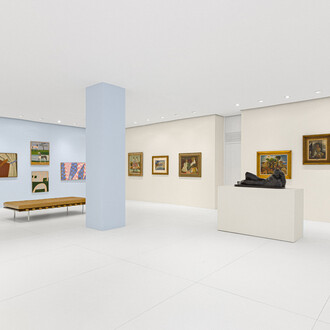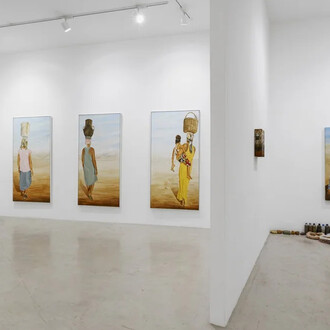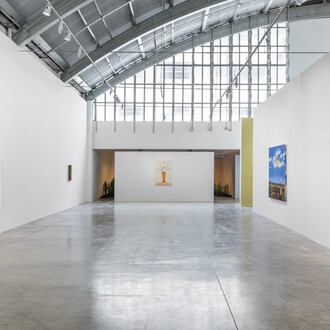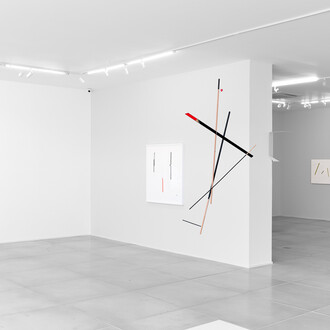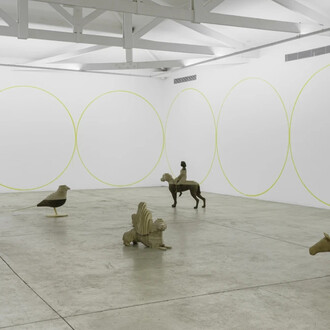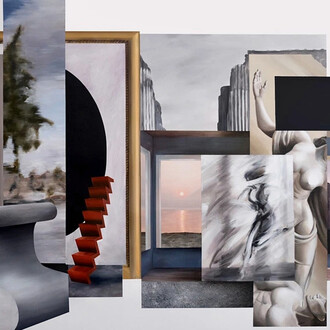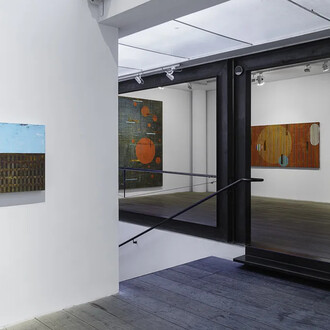From her earliest pieces to the most recent works, there’s coherence within her production. Marcia Pastore creates sculptural and installational shapes equipped with intrinsic autonomy and intellectual grasp, like pure acts of invention. The artistry, however, lies in the choice of materials and in their interactions within the provided space. She works with the physicism of materials, engines, energy force, weight, balance, barriers and the visible and invisible lines that result from these forces. The field emptiness is filled with these lines and energies she creates, replaying the viewer experience within her spatial traps. This is how she performs the work.
This performance is a mental effort, practice and plan. It’s her peculiar way of thinking and making art. She doesn’t sketch the tangible idea onto a paper sheet. It lies within mind range and then it’s performed on-site in real time. It may or may not work out. The artist goes out into the field armed with her ideas and, in order to perform them, she approaches the materials, connecting them, creating engines, spatial tensions and distensions. It’s a one-on-one job that may become an exhausting battle, given the physicality, spatial movements, and weight of these connections as well as the physical effort spent in the actions. The pieces turn into patient interrogations of the material; this is what it is hinted at.
Rocks, gypsum, plaster, cables, pulleys, unusual materials such as fishing nets. Physics, energy, lines, shapes and misshapes, water, glass, cables, fishhooks, graffiti, metals, dumbbells and so on, in a calculated diversity of materials, elements and forces that comprise her work. Forces which clearly design space. And, somehow, try to avoid evidence from the bodies.
Concentric, pendular, tension and balance forces while seeking for stability in the void to be filled by these lines of force. This is her construction technique when inventing spatial designs that create midpoints, perspectives, and fill the whole exhibition room.
Within their classic and modern monolithic layout, the sculptures, if that is indeed the term to be used having the canons of this language in mind, simulate forces acting onto themselves. It can be a pulley, a pendulum with a roughly cut rock. A rock hewn out of the wall, a fishnet hanging on the room walls and stretched to the point it creates a delicate air design within this tension on the whitish transparent matter. A sculpture formative process, made of rapprochements and responses, pulling and stretching, intersecting and tensioning until they turn into tangible purposeless traps, making the viewer deviate from the nature of these things within the actual set created by the artist.
They’re not sculptures in the sculpted monolith sense of the word… Also, she doesn’t understand sculpture as painting, depicting a (human, animal, or plant) body. They’re sculptures of surfaces, of movements, of connections, of engines, of controlled organicity and of relationships between bodies within the architectural space.
Spatial balance and stabilization are traversed by propelling lines. The emptiness of the exhibition room, or architectural space, is filled by these concentric, pendular, gravitational forces that build lines which create designs within the room. Visible and invisible traces of the connection of bodies and lines that patiently describe and fill the room.
The performance video and the still frames from the video are like images of the performances recorded on time. Engravings that imprint the air space and the layer of plaster on the floor. The set scene turns into a cosmic landscape on the performance-video. Frozen images transform into a semi- figuration of the galaxy within the simple act of throwing colored balls and splattering the white gypsum dust. It brings color to the exhibition and allows for the work to be open to involve the viewer.
The pieces are interrogations of the material and its forces that avoid figuration. Abstract indexes of physicality, reality and unreality only. There’s no final and exclusive interpretation, as well as there’s no temporary and approximate interpretation. There are no narratives.
It’s the viewer who creates the approach to the work, revealing their nature and expressing themselves. They become the piece and their perspective of the piece simultaneously (Umberto Eco), through the connections and disconnections of objects and lines within the exhibition space. The work presents itself as a way of thinking.









